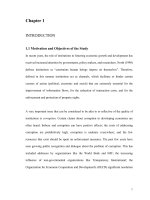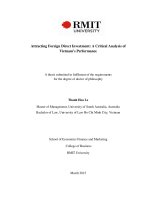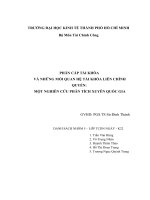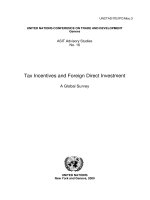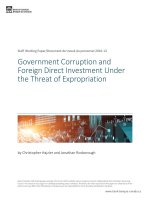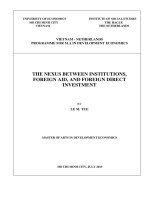Corruption and foreign direct investment a cross country study
Bạn đang xem bản rút gọn của tài liệu. Xem và tải ngay bản đầy đủ của tài liệu tại đây (300.46 KB, 59 trang )
Chapter 1
INTRODUCTION
1.1 Motivation and Objectives of the Study
In recent years, the role of institutions in fostering economic growth and development has
received increased attention by governments, policy makers, and researchers. North (1990)
defines institutions as “constraints human beings impose on themselves”. Therefore,
defined in this manner institutions act as channels, which facilitate or hinder certain
courses of action (political, economic and social) that are extremely essential for the
improvement of information flows, for the reduction of transaction costs, and for the
enforcement and protection of property rights.
A very important issue that can be considered to be akin to or reflective of the quality of
institutions is corruption. Certain claims about corruption in developing economies are
often heard: bribery and corruption can have positive effects; the costs of addressing
corruption are prohibitively high; corruption is endemic everywhere; and the few
resources that exist should be spent on enforcement measures. The past few years have
seen growing public recognition and dialogue about the problem of corruption. This has
included addresses by organizations like the World Bank and IMF; the increasing
influence of non-governmental organizations like Transparency International; the
Organization for Economic Cooperation and Development's (OECD) significant resolution
1
to criminalize bribery abroad; and a rapidly burgeoning body of theoretical and empirical
literature on the economic impact of corruption (Gray and Kaufmann 1998).
The general definition of corruption and the one adopted by the World Bank is “the use of
public office for private gain”. However, it must be noted that corruption is not restricted
only to the public sphere and can co-exist even in the private sector. Indeed, often the term
corruption is used synonymously with bribery, extortion and fraud.
The central question that is addressed in this paper is whether the phenomenon of
corruption has any effect on foreign direct investment (FDI). The theoretical literature on
corruption is vast1. One can divide the assumptions and conclusions of these papers into
generally two strands—many papers have looked upon corruption as a phenomenon that
has severe negative effects, and the construction of the models in this category reflects this
assumption. A relatively fewer number of papers on the other hand argue that corruption
can have positive effects. Given that the literature tells us there is scope for both types of
effects to occur, this forms the first motivation for the thesis.
Secondly, even though the theoretical literature on corruption in general is extensive, its
relationship with FDI in theory has been scantly studied so far. Further, the empirical
literature in this area does not present any consensus on the results—some papers present a
negative relationship between corruption and FDI, while others posit that corruption has
no significant (statistical) influence on direct foreign investment. We also observe large
amounts of FDI going into countries even where the perceived level of corruption is high,
1
See Chapter 2 on “Review of literature” for a brief insight into the theoretical literature.
2
for e.g. China, Indonesia, Mexico, Argentina, and Brazil among others. Therefore, it may
be possible to argue that corruption is a small cost that investors are willing to bear, and
that other factors such as attractive domestic returns, cheap labor, large domestic demand
and so on play the major role in attracting FDI.
Given this background, the objectives of the study are therefore, twofold:
(1) To present a simple theoretical model that will illustrate the relationship between
corruption and FDI.
(2) To re-examine if the relationship between corruption and FDI is empirically borne
out by using a broad set of panel data.
1.2 Organization of the Study
The organization of the thesis is as follows: Chapter 2 reviews the literature on corruption
and FDI. A simple theoretical model of corruption and FDI is developed in Chapter 3;
some properties of the model are examined and implications of the theoretical results
derived therein are discussed. The data and methodology adopted to test the empirical
relationship between FDI and corruption are presented in Chapter 4. Chapter 5 discusses
the empirical results. The conclusions of this study along with some directions for future
research are presented in Chapter 6.
3
Chapter 2
REVIEW OF THE LITERATURE
2.1 Introduction
This chapter briefly introduces the literature on corruption and goes on to review the
literature pertaining to corruption and FDI in detail.
One of the first economic analyses of corruption was carried out by Becker (1968). Becker
uses economic analysis to develop optimal public and private policies to combat illegal
behavior. Since then, many studies, both theoretical and empirical have examined the
relationship of corruption with a variety of economic variables. On the theoretical side,
Rose-Ackerman (1975), Lui (1985) and Sheilfer and Vishny (1993) are some of the
seminal studies in the area of corruption.
While most of the theoretical studies examine the negative effects of corruption, a
relatively fewer number of studies state that corruption can have positive effects—for
instance Lui (1985) studies the impact of bribery in the context of a queue where
customers having different values of time are ranked by order of their bribe payments to
the server of the queue. The author shows that the bribing strategies of customers who
have different time preference form a Nash equilibrium that minimizes the average value
of the time costs.
On the empirical front, one of the earliest known studies of corruption is by Wade (1985)
4
who studies corruption in irrigation administration in South India. Since then, many
studies have estimated the effect of corruption on a variety of macroeconomic variables
like economic growth (Mauro 1995), government expenditure (Mauro 1998), investment
(Mauro 1995; Wei 2000) and so on. The study by Mauro (1995) deserves special mention
here, as this was the first study to examine the phenomenon of corruption across countries
and over time. Using cross section data for about 67 countries for the period 1980-’83 the
author finds that corruption has a statistically significant negative effect on investment and
economic growth. However, empirical evidence on the relationship between corruption
and FDI has so far presented a mixed picture. The following section reviews the empirical
literature on the effects of corruption on FDI.
2.2 Corruption and Foreign Direct Investment
Empirical work on the effects of corruption on FDI has been of fairly recent vintage and
indeed, began only in the 1990s. Wheeler and Mody (1992) in a study of foreign
investment of US firms, fail to find a statistically significant correlation between the size
of FDI and the host country’s risk factor, a composite measure that includes corruption as
one of its components. The authors use data on a composite measure of risk taken from
Business International (BI, now incorporated into the Economic Intelligence Unit). They
focus on investments in the manufacturing sector by US multinationals in 42 countries for
the period 1982-’88. The authors find that US investors give almost all the decision weight
to agglomeration benefits (increasing returns that occur to economic units due to colocation) like infrastructure quality in developing economies and specialized support
services in industrialized economies, and to factors such as market size which was found
5
to eclipse labor cost as national income level rose. The authors conclude that the
importance of the risk factor should “be discounted, although it would not be impossible to
assign it some small weight as a decision factor” (p.70).
Hines (1995) uses data on US foreign investment in 35 countries for the period after 1977
and fails to find a significant relationship between total inward FDI and corruption in the
host country. He uses corruption data from BI and studies four indicators of US foreign
investment in host countries: FDI, capital/labor ratios, joint venture activities and aircraft
exports. He finds no clear evidence for the fact that the anti-bribery laws enacted in the US
influenced its investment in corrupt countries. According to the author, “…it is noteworthy
that local corruption has an insignificant effect on post-1977 growth of FDI….” (p.20).
Using cross-country data for a set of 10 developing Asian economies (other than Japan
and the Middle East) Lipsey (1999) analyzes the location choice of US affiliates in Asia.
The author defines location by the size of operation, which is measured by variables such
as the stock of investment, employment, and production (as in gross product) sales. The
author does not exclusively address the issue of corruption but instead, uses two measures
of institutional characteristics in his study: an index of overall competitiveness published
in the World Competitiveness Report by the World Economic Forum, and a corruption
index used in Mauro’s (1995) study and reported by BI. He also examines factors such as
the degree of export orientation, capital intensity, dependence on imports from the United
States, and extent of research and development. Using regression analysis, the author finds
that variables such as market size, distance from the United States, per capita income and
tax rates of US affiliates explained half the variation among the FDI recipient countries in
6
terms of attracting US FDI. He also finds that corruption has a statistically significant
negative impact on US FDI in Asian countries. Alternatively, countries that had the
highest level of US FDI also ranked high apropos measures of institutional characteristics
including low levels of perceived corruption. However, when the Asian economies were
ranked by their deviations from the equations, the effect of institutional variables became
less clear.
Using data on 52 countries over the years 1991-1995, Drabek and Payne (1999) find that
controlling for other factors, host countries’ attractiveness to foreign investors is closely
connected to the degree of transparency. The authors use a “Transparency index” from the
International Country Risk Guide (ICRG), which essentially bundles several variables
such as the level of corruption, law and order, and bureaucratic quality, among others.
They use 2SLS and simulation exercises and find a significant positive impact of
transparency (higher rank indicating a higher level of transparency) on FDI. However,
when individual elements of the Transparency Index were used, the effect on FDI was less
significant.
Wei (2000) studies the impact of corruption on bilateral investment from twelve source
countries to forty-five host countries in 1993. He uses three separate corruption indexes
from BI, ICRG and Transparency International (TI) respectively. First, using the OLS
method, the author regresses FDI on corruption, tax rate and a set of control variables.
Results indicate that a rise in the level of corruption or tax rate in the host country reduces
inward FDI in a statistically significant manner. Next, a modified version of the Tobit
model is used to take account of zero-FDI values that were dropped in the previous
7
estimation (a Double-Log linear model was used previously). Results are qualitatively the
same as in the previous case. The paper concludes that corruption reduces FDI in a way
that is statistically as well as quantitatively large. In addition, the author finds that despite
the Foreign Corrupt Practices Act of 1977, American investors are no more averse to host
country corruption than other investors.
In a study where the choice of entry mode of foreign investors is analyzed, Smarynzka and
Wei (2000) find that corruption has a significant effect on the choice of entry mode of the
foreign investor. The authors use extensive firm level data on foreign investment in 73
East-European countries for the period 1988-1995. They use data on corruption from the
World Bank and TI. Controlling for investors’ technological sophistication, firm size,
production diversification, GDP and other factors, the authors find that corruption in the
host country makes the foreign investor prefer a joint venture to single ownership.
However, the authors conclude that if foreign investors have sophisticated technology,
they are less inclined to forming joint ventures due to fear of technological leakage.
Habib and Zurawicki (2002) examine the effect of corruption on bilateral FDI using data
on 89 countries for the period 1996-1998. They use bilateral FDI data from the
International Monetary Fund (IMF 2000) and data on corruption is taken from TI. Seven
home countries are included in their analysis. They first analyze the effect of host country
corruption on FDI. Then, the impact of the absolute difference between the corruption
levels of the home and host countries is analyzed using the PROBIT approach. Both
analyses are carried out by simultaneously controlling for other factors such as population,
GDP growth, and unemployment among others. In the first case, corruption is found to
8
have a statistically significant (at less than 5 percent significance level) negative impact on
FDI.
However, when the authors introduce variables such as political stability, the
significance of the corruption variable decreases (although still negative in sign). In the
second case, using the absolute difference in the corruption levels between the home and
host countries, the authors find corruption to still have a negative significant impact on
FDI, although results are only marginally significant (i.e. at the 10 percent significance
level).
The literature review in this section clearly presents a mixed picture on the empirical
relationship between corruption and FDI. Therefore, in the next and chapters to follow, we
attempt to present a theoretical as well as empirical testing of the relationship between
corruption and FDI.
9
Chapter 3
THEORETICAL FRAMEWORK
3.1 Introduction
This chapter sets forth a simple model, which is used to analyze the relationship between
corruption and foreign direct Investment. The question that is addressed here and which
indeed forms the central thrust of this chapter is whether corruption has any effect on FDI.
Theoretical literature on corruption has so far treated it as having either a negative or
positive impact. No theoretical model so far has explored the possibility that corruption
can have different effects based on how the parameters of a model change (in the real
world, how different economic, social and political factors change). Given this
background, the construction of a theoretical model of corruption and FDI, which can
throw some additional light in this area, appears important.
3.2 The Model
We consider a situation where a foreign firm would be a monopolist in the host market if
allowed to enter. The firm is faced with a choice of whether or not to invest abroad. The
firm’s investment decision and therefore, its actual investment I is based on the traditional
cost-benefit analysis—benefits can take the form of increased returns from engaging in
FDI, cheap labor, large domestic market, and so on, while high taxes, poor infrastructure
and corruption (bribery) are examples of potential costs faced by the foreign firm in the
10
host market. A necessary condition for foreign investment to occur is that potential
benefits should exceed likely costs.
We assume that the investing firm has to go through a regulator or controller in the host
market who can be considered a top-level government official or a bureaucrat and who in
turn, has some control over the FDI decision process—in our model, the regulator sets the
price, p for the investing firm’s product/service (s). The regulator can be either corrupt or
honest. We denote the response of the regulator to corruption by β . A higher β means a
regulator who is more responsive to bribe. Also, as price is determined by the controller
(explained in the following paragraphs), β captures the propensity to raise price with
respect to bribe. β =0 if the regulator is honest and is greater than 0 if the regulator is
corrupt.
If the host country regulator is corrupt, the investing firm may offer the regulator a certain
level of bribe B in order to obtain a better price for its product/service (s). Like the
regulator and perhaps more so, the foreign firm can be assumed without loss of generality
to take its only goal as the maximization of profits and this end will justify the “means” it
adopts.
The model is set in the current period. That is, this is a one period model where
adjustments take place instantaneously without time lags. Alternatively, the actors in the
model are making decisions in a time period that stretches to infinity so that this can be
compressed to or thought of as involving only one period. This while ignoring the role of
11
important dynamics like expectations makes the model simpler and illustrative of the key
issues which we are concerned with.
There are therefore, two players in this game. On one side is the investing firm with profit
maximization as its only goal. And on the other side is the regulator who is only concerned
with maximizing his utility. To solve this game we treat this as a Stackleberg game. The
investing firm is the Stackleberg leader that moves first and in doing so chooses an
investment level, I and bribe level, B.
The regulator is the follower who simply reacts to the investing firm’s decisions by setting
a price. Further, it is assumed that the foreign firm has complete information about the
regulator and therefore, knows the regulator’s response function. The implication of this
assumption is that, although the regulator sets the price, the firm is able to indirectly
control it, as it is able to predict the regulator’s response to its decisions. Furthermore, the
regulator is also assumed to know the investing firm’s profits.
3.2.1 Investor’s maximization problem
The investing firm’s main problem is that of profit maximization. Given, a certain demand
curve and cost, c the firm will produce quantity, q and choose an investment level I and
bribe B that will maximize its profits. We therefore represent the firm’s profit function in
the following manner:
π = (p − c )q − B
12
We assume that q = a-p. The demand curve is assumed to be linear for the sake of
simplicity. The cost function is defined as c = R / I , where R is a cost parameter greater
than 0. The cost function depicts an inverse relationship of cost with investment—as
investment increases the cost per unit will go down. Therefore,
π = (p −
R
)(a − p) − B
I
(1)
3.2.2 Regulator’s problem
The regulator’s utility function is written as a function of the following variables:
1
U = U q, B,
p
(2)
The utility of the regulator is assumed to depend inversely on price, and he therefore, aims
to set a low price. This assumption captures the idea that a lower price is indicative of a
better performance on the part of the regulator in the eyes of the authorities. However, a
low price may imply lower investment and therefore, lower addition to output and
employment. The controller has to therefore, trade-off between price and the investment
level. However, he may be willing to consider the trade-off more favorably if offered a
bribe.
The response function of the regulator is the price function. We assume that the price set
by the regulator depends inversely on the firm’s profits, and positively on the investment
level and bribe offered respectively. There is an attempt here by the regulator, as
13
mentioned earlier, to balance between investment and profits. On the one hand, higher
profits indicate that the investor may be willing to take a low price and still invest. As a
result, the regulator will try to decrease the price as profits increase. However, on the other
hand, the regulator is keen on allowing high investment as this can generate more
employment in the economy, and is therefore willing to tolerate a high price. Therefore,
p = απ + γI + βB ;
α < 0; γ >0; β ≥ 0.
(3)
In the above expression, the parameters α, γ and β capture the regulator’s responsiveness
to profits, investment and bribe respectively. With higher profits, the regulator will set a
lower price because the regulator cannot allow the firm to earn abnormally high profits.
Therefore, profits and p are inversely related.
Price p and investment I are positively related as higher investment is viewed as being
beneficial for the economy in terms of making more employment opportunities available
and thus, contributing to economic growth. β captures the response of the regulator to
bribe B. Therefore, if β =0, bribery will have no effect on prices and if β >0, the higher
will be the price, the higher the bribe. The parameters α , γ and β are known to the
regulator as well as the investing firm.
Given the backdrop, we are mainly interested in knowing how β (corruption) impacts on
investment I; whether a higher β implies a higher or lower investment. To solve this
model, the investor’s objective function in equation (1) must be maximized with respect to
14
bribery B and investment I. This is done by substituting equation (3) in (1) and thus,
obtaining
R
I
π = (απ + γI + βB − )(a − απ − γI − βB) − B
(4)
Since the investing firm’s choice variables are B and I, we obtain the first-order-conditions
with respect to B and I from equation (4) and solve the resulting system of simultaneous
equations. We consider two cases: we first look at the case where the regulator is honest
i.e. β =0 and then at the case of the corrupt regulator i.e. β >0. But before proceeding
further, it would be useful to analyze the case where there is no regulator in the host
market, as this would enable us to draw useful comparisons.
3.3 No Regulator
Let us first consider the case where there is no regulator in the host market to control the
foreign firm’s price and output. The investing firm is therefore free to choose its price so as
to maximize profits. It hence chooses an optimal price so as to maximize
R
π = p − (a − p )
I
∂π
1
R
= 0 ⇒ p* = a +
∂p
2
I
Substituting this value of p* into the firm’s profit equation above we get
1
R R
1
R
π* = a + − a − a +
I I
2
I
2
15
R
1
⇒ π* = a −
4
I
2
(5)
Therefore, from the above expression for π* , we can see that the foreign firm in the absence
of a regulator will make as large an amount of investment as possible. As seen from the cost
function c = R / I, a larger investment means a lower average cost and therefore, higher
profits.
3.4 The Honest Regulator ( β =0)
In the case where the regulator is honest, the investing firm’s profit function and the
regulator’s price function will take modified versions of equation (4) and (3) respectively.
The regulator’s response function if he is honest is
p = απ + γI
(6)
Therefore, the firm’s maximization problem is
π = (απ + γI −
R
)(a − απ − γI)
I
(7)
In this case, the foreign firm’s choice variable is reduced to only investment I. In the
following steps, the first-order-condition of π with respect to investment is derived.
∂π / ∂I = 0
⇒ −2αγπ + γa − 2γ 2 I +
⇒ π* =
R
Rαπ
a− 2 =0
2
I
I
aγI 2 − 2 γ 2 I 3 + aR
α 2γI 2 + R
(
)
(8)
16
In the above equation, since α is negative, π* is positive only if the firm makes an
investment of at least
a
.
2γ
Proposition 1
In the absence of any regulator, the investing firm will choose as large a level of investment
as possible. This level of investment will be at least
R
. However, in the presence of an
a
honest regulator, the investment level will be at least
a
, and is given by the solutions to
2γ
equations (7) and (8).
Proof
From equation (5), we know that for π* to be positive, investment should be at least
R
.
a
From equations (7) and (8), we see that the level of investment should be at least
a
.
2γ
However, we are not able to explicitly solve for the optimal level of investment.
3.5 The Corrupt Regulator ( β >0)
We examine the relationship between I, β and B when the regulator is corrupt. In this case,
as π = (απ + γI + βB −
R
)(a − απ − γI − β B) − B , the optimal level of bribery B and
I
investment I are accordingly given by the following first-order-conditions.
17
∂π / ∂B = 0
R
⇒ απ + γI + β B − (− β) + (a − απ − γI − β B)(β ) − 1 = 0
I
⇒ −2β(απ + γI + βB) + aβ +
Rβ
−1 = 0
I
(9)
∂π / ∂I = 0
R
R
⇒ απ + γI + β B − (− γ ) + (a − απ − γI − βB) γ + 2 = 0
I
I
Ra Rγ
R
=0
⇒ (απ + γI + β B) − 2γ − 2 + aγ + 2 +
I
I
I
(10)
From (9),
απ + γI + β B =
1 − aβ −
Rβ
I
(− 2β )
(11)
Substituting (11) into (10) we get
Rβ
I 2γ + R
(2β )
I2
1 − aβ −
Ra Rγ
=0
+ aγ + 2 +
I
I
The above equation can be re-written as follows:
R2
γ 3 1 + aβ
RI −
I +
=0
2
β
2β
(12)
18
Proposition 2
In the presence of a corrupt regulator, the level of investment I will be lower than
R
.
a
Furthermore, the higher the regulator’s propensity to raise prices through bribery, the higher
will be the level of investment.
Proof
From equation (12) we know,
β=
γI 3 +
R
I
2
(13)
R
(R − aI)
2
Since β > 0, the level of investment made by the firm should be less than
R
; and as β
a
increases, I must also increase.2 It is again not possible to explicitly solve for the optimal
level of investment.
From the preceding analysis we know that investment in the presence of an honest regulator
will be at least
a
. When there is a corrupt regulator, the level of investment made by the
2γ
firm will be no more than
R
. Therefore, for the investing firm to make a higher investment
a
in the presence of a corrupt regulator than an honest one,
R
a
>
. However, we do not
a
2γ
know if this condition will be satisfied as R, a, and γ in the above expression are in no
manner related to each other.
2
Refer to Appendix 3a for complete proof.
19
Proposition 3
If in the case of a corrupt regulator the level of investment made by the foreign firm is
greater than
R
R
R
, i.e. if investment is in the range
< I < , then a higher β implies a
2a
2a
a
lower bribe B.
Proof
Let απ + γI + βB = E
We know from equations (10) and (11) that
απ + γI + βB =
απ + γI + βB =
Ra Rγ
−
I ; and
I2
R
− 2γ − 2
I
− aγ −
1
R 1
a + −
2
I 2β
(14)
(15)
Also, equation (4):
R
I
π = (απ + γI + βB − )(a − απ − γI − βB) − B
can be written as
π = (E −
R
)(a − E) − B
I
(16)
submitting (16) into (15) we get
α(E −
R
1
R 1
)(a − E) − αB + γI + βB = a + −
I
2
I 2β
20
R
−a 1
R
I
− + (a − γI ) + (− α )( − E)(E − a )
2β
I
2
⇒B=
β−α
From the above expression we can see that if I >
(17)
R
, then with a higher β , B will
2a
decrease.3
3.6 Conclusions
This chapter has presented a simple model to analyze the relationship between corruption
and foreign direct investment. The investing firm is assumed to be a special case of a
monopolist in the model and corruption is being captured by the parameter β . Moreover, a
higher β is taken to mean a regulator who is more responsive to bribe. We do not derive an
explicit expression for the optimal investment level under different cases considered in the
model, as it is not possible to find a solution to the equations. Within the confines of the
model and from the theoretical results derived in this chapter, the following conclusions are
drawn.
When there is a corrupt regulator in the host market, bribery can facilitate FDI. However,
the level of investment in the case of the corrupt regulator may be higher, lower or equal to
the investment under the honest regulator’s case. In other words, bribery can facilitate FDI
within a region of corruption, but based on our results, it is unknown if this level of
investment will be greater than the investment made in the absence of corruption. This will
3
Refer to Appendix 3b for complete proof.
21
depend on whether
R
a
>
in the model, which will further depend on the way R, a, and γ
a
2γ
interact with each other.
If the regulator is corrupt, results indicate that investment made by the foreign firm will be
low i.e. I <
R
. The main goal of the monopolist is to get a high price from the regulator
a
and in this case, also push its investment to a higher level. As the regulator becomes more
corrupt, the foreign firm is able to get more out of the regulator at a lesser cost.4 Further,
the monopolist firm can also influence price through higher investment ( p = απ + γI + βB ).
Therefore, in order to get a more favorable price, the investing firm will choose to increase
its investment rather than bribe. This is because, as the regulator becomes more corrupt, the
firm can extract favors out of the regulator at a lesser cost and put the extra dollar saved into
more investment. However, our results indicate that only when I is in the range
R
R
a
bribery will decrease. This means that if the firm is willing to make an investment which is
at least half of what it would make under a corrupt regulator, then a higher β will mean
lower bribery. When investment does not fall in this range, the effect on bribery is
ambiguous.
When the regulator is honest and therefore, investment I >
a
, the investing firm has to
2γ
increase its investment to a very high level in order to extract the desired response from the
4
A higher β as defined earlier in this chapter means a regulator who is very responsive to bribery. This in
turn implies that more favors can be bought from him at a lesser cost.
22
regulator. This is because the regulator’s propensity to raise prices via higher investment is
low (captured by a low γ in the above expression). In the absence of any regulator in the
host market the investing firm will choose a large investment level of at least
R
. The
a
monopolist firm, being free to choose its own output and price will naturally make the
highest investment, and set the maximum price possible. Therefore, price, investment and
profits will be the maximum possible under this case.
If the regulator is honest, the foreign firm has to adhere to the price/investment controls
imposed by the regulator. A corrupt regulator on the other hand gives the firm an
opportunity to increase its price and investment further. It is thus, likely that an investing
firm will make a higher investment and set a higher price when a corrupt regulator rather
than an honest one regulates the host market. However, the foreign firm will be better off in
the absence of any regulator at all. And if there is a regulator in the host market, the
investing firm will be able to achieve a higher investment and price in the presence of
corruption. But the welfare loss to the consumers, who will bear the brunt of the price
increase, is likely to be the highest in the case without a regulator and least in the case of an
honest regulator.
In the next two chapters, using panel regression analysis we attempt to test whether the
theoretical results derived in this chapter hold empirically. The next chapter presents the
data and methodology.
23
Chapter 4
DATA AND METHODOLOGY
4.1 Introduction
To test whether the theoretical conclusions reached in Chapter 3 are empirically borne out
or in other words, in order to establish an empirical relationship between FDI and
corruption panel regression analysis is used. This chapter is organized as follows: in the
first part of this chapter, the methodology and econometric model used to test the
empirical relationship between FDI and corruption are described. The data is discussed in
detail in the second section. Select descriptive statistics on the data are presented in
Appendix 4b.
4.2 Econometric Model and Methodology
The regression analysis carried out in this chapter makes use of panel data. There are
several advantages of using panel or pooled cross-section and time-series data, which
allows one to observe differences in the behavior of individual units both across cross
sections as well as over time.
Firstly, a natural advantage is the increase in the number of observations and therefore,
more variation in the data. This principally should lead to more efficient estimates of the
parameters. Secondly, even though more variables are added in a multiple regression
framework to deal with omitted variable bias, it is not always possible to control for a
24
wide range of factors. This being the case, the resultant estimates will be biased as well as
inconsistent. One way to get around this problem in panel data analysis is by considering
these effects as unobserved, which vary across individual units and/or time.
The literature on the determinants of FDI does not suggest any model in particular that can
be adopted to test the relationship between FDI and its determinants. Most empirical work
in this area has extended the “Gravity-Model” of international trade to analyze the flow of
FDI. This is essentially a model in the log framework. We are however, unable to use a
log model because of several negative values that the FDI data takes. With this
background, we construct a parsimonious model in this section that is linear in its
parameters. We use a model known as the Fixed Effects (FE) model where the unobserved
factors are taken as parameters to be estimated.
4.2.1 Econometric Specification
Our basic model takes the following form:
yit = xitβ + δi+ εit ,
i =1,…,N and t =1,…,T
(17)
where yit and xit represent the dependent and independent variables respectively for the ith
country at time t; δi represents unobserved factors which are time invariant and specific to
each country; and εit represents the remaining effects which are assumed to vary over both
(
)
individuals and time periods. It is assumed that εit ~ IN 0, σ 2 . The Fixed Effects model
25
